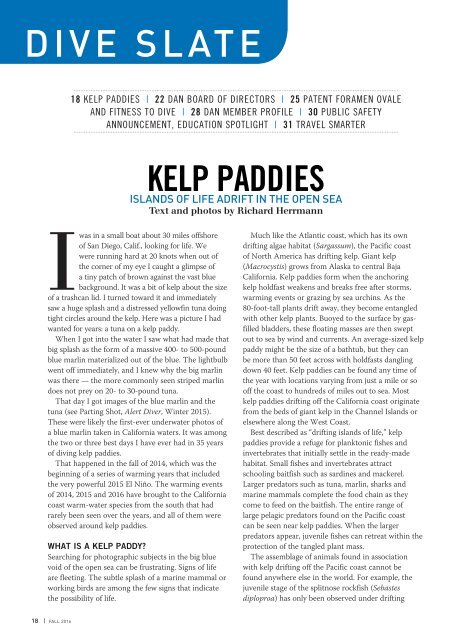AD 2016 Q4
Alert Diver is the dive industry’s leading publication. Featuring DAN’s core content of dive safety, research, education and medical information, each issue is a must-read reference, archived and shared by passionate scuba enthusiasts. In addition, Alert Diver showcases fascinating dive destinations and marine environmental topics through images from the world’s greatest underwater photographers and stories from the most experienced and eloquent dive journalists in the business.
Alert Diver is the dive industry’s leading publication. Featuring DAN’s core content of dive safety, research, education and medical information, each issue is a must-read reference, archived and shared by passionate scuba enthusiasts. In addition, Alert Diver showcases fascinating dive destinations and marine environmental topics through images from the world’s greatest underwater photographers and stories from the most experienced and eloquent dive journalists in the business.
Create successful ePaper yourself
Turn your PDF publications into a flip-book with our unique Google optimized e-Paper software.
DIVE SLATE<br />
18 KELP P<strong>AD</strong>DIES | 22 DAN BOARD OF DIRECTORS | 25 PATENT FORAMEN OVALE<br />
AND FITNESS TO DIVE | 28 DAN MEMBER PROFILE | 30 PUBLIC SAFETY<br />
ANNOUNCEMENT, EDUCATION SPOTLIGHT | 31 TRAVEL SMARTER<br />
KELP P<strong>AD</strong>DIES<br />
ISLANDS OF LIFE <strong>AD</strong>RIFT IN THE OPEN SEA<br />
Text and photos by Richard Herrmann<br />
I<br />
was in a small boat about 30 miles offshore<br />
of San Diego, Calif., looking for life. We<br />
were running hard at 20 knots when out of<br />
the corner of my eye I caught a glimpse of<br />
a tiny patch of brown against the vast blue<br />
background. It was a bit of kelp about the size<br />
of a trashcan lid. I turned toward it and immediately<br />
saw a huge splash and a distressed yellowfin tuna doing<br />
tight circles around the kelp. Here was a picture I had<br />
wanted for years: a tuna on a kelp paddy.<br />
When I got into the water I saw what had made that<br />
big splash as the form of a massive 400- to 500-pound<br />
blue marlin materialized out of the blue. The lightbulb<br />
went off immediately, and I knew why the big marlin<br />
was there — the more commonly seen striped marlin<br />
does not prey on 20- to 30-pound tuna.<br />
That day I got images of the blue marlin and the<br />
tuna (see Parting Shot, Alert Diver, Winter 2015).<br />
These were likely the first-ever underwater photos of<br />
a blue marlin taken in California waters. It was among<br />
the two or three best days I have ever had in 35 years<br />
of diving kelp paddies.<br />
That happened in the fall of 2014, which was the<br />
beginning of a series of warming years that included<br />
the very powerful 2015 El Niño. The warming events<br />
of 2014, 2015 and <strong>2016</strong> have brought to the California<br />
coast warm-water species from the south that had<br />
rarely been seen over the years, and all of them were<br />
observed around kelp paddies.<br />
WHAT IS A KELP P<strong>AD</strong>DY?<br />
Searching for photographic subjects in the big blue<br />
void of the open sea can be frustrating. Signs of life<br />
are fleeting. The subtle splash of a marine mammal or<br />
working birds are among the few signs that indicate<br />
the possibility of life.<br />
Much like the Atlantic coast, which has its own<br />
drifting algae habitat (Sargassum), the Pacific coast<br />
of North America has drifting kelp. Giant kelp<br />
(Macrocystis) grows from Alaska to central Baja<br />
California. Kelp paddies form when the anchoring<br />
kelp holdfast weakens and breaks free after storms,<br />
warming events or grazing by sea urchins. As the<br />
80-foot-tall plants drift away, they become entangled<br />
with other kelp plants. Buoyed to the surface by gasfilled<br />
bladders, these floating masses are then swept<br />
out to sea by wind and currents. An average-sized kelp<br />
paddy might be the size of a bathtub, but they can<br />
be more than 50 feet across with holdfasts dangling<br />
down 40 feet. Kelp paddies can be found any time of<br />
the year with locations varying from just a mile or so<br />
off the coast to hundreds of miles out to sea. Most<br />
kelp paddies drifting off the California coast originate<br />
from the beds of giant kelp in the Channel Islands or<br />
elsewhere along the West Coast.<br />
Best described as “drifting islands of life,” kelp<br />
paddies provide a refuge for planktonic fishes and<br />
invertebrates that initially settle in the ready-made<br />
habitat. Small fishes and invertebrates attract<br />
schooling baitfish such as sardines and mackerel.<br />
Larger predators such as tuna, marlin, sharks and<br />
marine mammals complete the food chain as they<br />
come to feed on the baitfish. The entire range of<br />
large pelagic predators found on the Pacific coast<br />
can be seen near kelp paddies. When the larger<br />
predators appear, juvenile fishes can retreat within the<br />
protection of the tangled plant mass.<br />
The assemblage of animals found in association<br />
with kelp drifting off the Pacific coast cannot be<br />
found anywhere else in the world. For example, the<br />
juvenile stage of the splitnose rockfish (Sebastes<br />
diploproa) has only been observed under drifting<br />
18 | FALL <strong>2016</strong>










